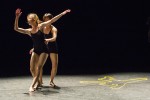A dancer in a black shirt moves slowly, silhouetted against a dim gray background and surrounded by performers in khaki trench coats. In an instant, the dancer is indistinguishable from the other performers – he is now draped in a khaki trench coat, cloaking his identity from the audience.
The dancer soon sheds the trench coat and becomes an individual again, separated from the crowd, symbolizing the cyclical and transient nature of identity.
The modern dance piece, “My Dear,” is from a two-part showcase titled “My Dear and Displacement II.” Hsiao-Mei Ho, associate professor of dance at Taipei National University of the Arts in Taiwan, choreographed “My Dear,” and Cheng-Chieh Yu, an associate professor in the world arts and cultures/dance department at UCLA, choreographed “Displacement.” Ho said the showcase marks the first time she and Yu have collaborated on a show since they were graduate students together around 25 years ago. The event will take place Friday at the Glorya Kaufman Theater.
As undergraduates, Yu and Ho were classmates in the dance department at Taipei National University of the Arts. While at the university, the two received similar training in the Martha Graham style of modern dance, which Yu said deals with contraction and release of human body movements.
After they graduated, Yu and Ho relocated to New York City to pursue additional studies in dance performance at New York University. Ho continued to immerse herself in the Graham style of modern dance, which Yu said infused a scientific precision into Ho’s choreography.
In New York, Yu said she discovered the postmodern genre, which involves dance choreography based on openness and freedom.
After graduate school, the two parted ways in 1991. Ho returned to Taiwan to teach at Taipei National University of the Arts while Yu traveled in the States and around the world to perform.
“(Ho has been) very grounded, very rooted in Taiwan since 1991. I am not rooted – I’ve been floating around in the world for the past 20-something years,” Yu said. “We had that connection, and now … our work has diverted.”
Ho said “My Dear” embodies the Buddhist beliefs of reincarnation to repair mistakes in past lives. The piece emphasizes the importance of love, representing the motivation to cycle through birth and death.
“Love is painful but also tender,” Ho said. “Because of love, we want to come back again.”
For “Displacement,” Yu said she worked with professional dancers from Taiwan to study how performers from different cultures respond to a set choreographic score influenced by an unfamiliar environment.
Yu said she is interested to see how America, a new environment for many of the dancers, influences their interpretations of the choreography.
Kuan-Ling Tsai, one of the professional dancers in Yu’s set and an ex-student of Ho’s, said Yu placed solos into “Displacement” that allowed the dancers to meld their own interpretations into the dance.
Tsai said the displacement she studied in Yu’s choreography has extended to her personal journey. In the last 10 years since she graduated with her master’s of fine arts in dance under Ho’s tutelage at Taipei National, Tsai moved from Taiwan to Zurich, Switzerland to New York City and back again.
Because she said she has loved ones waiting for her in the three locations, thinking about her three homes gives her a sense of joy but also a feeling of emptiness.
“I sometimes feel I am not complete because I have part of me here, a part of me there (in the countries I left),” Tsai said. “They never cross. I am never complete in any location.”
While the dancers already have their own understanding of the work, Yu said she hopes “My Dear and Displacement II” can help move audience members away from phone or computer screens.
The goal, Yu said, is to connect spectators with performers through the live language of dance.
“We connect through the skin of media, and often we forget our human complexities and how we communicate,” Yu said. “Dance works around our reality on the screen and has the power (to facilitate) actual human engagement.”
